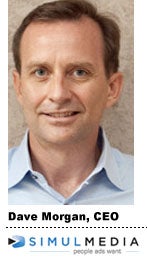 The adoption of programmatic selling practices by television ad brokers, buyers and planners has been occurring in a number of ways over the last few years. But progress has been too glacial in the view of Dave Morgan, CEO of TV ad targeter Simulmedia. So he’s expanding the company’s offer of free reach and frequency data with plans to show how effective – or, rather, ineffective – most video advertising is.
The adoption of programmatic selling practices by television ad brokers, buyers and planners has been occurring in a number of ways over the last few years. But progress has been too glacial in the view of Dave Morgan, CEO of TV ad targeter Simulmedia. So he’s expanding the company’s offer of free reach and frequency data with plans to show how effective – or, rather, ineffective – most video advertising is.
Last May, the New York-based company started its Open Access Project on its website. The data and tools within the OAP allow anyone free access to parts of Simulmedia’s database that show how specific marketers and networks performed according to reach, frequency and cost on recent national TV campaigns from hundreds of national advertisers. The data goes back three years and up to about two months ago.
Asked if the changes being pursued by Simulmedia and its rivals to make TV ad sales more like online, particularly in the area of audience buying, will diminish TV’s long-held value as a mass medium for branding dollars, Morgan said that the opposite would be the case.
“The TV audience is already fragmented, for one thing,” Morgan said. “The thing is, that’s not the industry’s biggest problem – though it is often the thing most often complained about. No, the problem is that only 30% of audience targets are being reached and that uncertainty is holding back spending. The culprit is in the ton of run-of-network crap that are dumped on TV campaigns. If you want the stars, you have to buy the dogs. We want to let buyers know exactly what those dogs are costing them. Once they know that, they’ll feel more free to spend, enhancing TV’s accepted power as a brand medium.”
By the fall, Simulmedia plans to update the OAP data weekly and allow users to see what happened as recently as a month prior – which is one or two months better than what TV buyers and sellers generally see, Morgan said.
“Once they understand the level of inefficiency at work, how 70% of TV dollars are currently wasted because they’re not hitting their targeted audience, that will accelerate the interest in a more programmatic approach to TV,” he added
Morgan is quick to clarify that by programmatic, he does not mean that any sort of real-time bidding is about to take over TV buying. He doesn’t see that happening for another seven to 10 years. He does however expect to see faxes and gross ratings points begin to give way to increased automation and predictive data to better inform TV placements and cross-platform video buys.
So far, companies like Centro and Mediaocean are trying to engage broadcast and cable buyers in similar ways. But Morgan believes giving data and tools away for free is a more painless way to change practices. For one thing, he said that media buyers and sellers aren’t that reflective and don’t often take a deep look at “what could have been” when assessing past campaigns along reach and frequency lines.
In a brief demonstration of the OAP, users can search the TV buying activity of any brand marketer by name and compare dollar figures as well as reach and frequency numbers across 50 networks. They can drill down on those numbers according to nine different demographic categories, such as women aged 25 to 54. The additions coming to the free service this fall include the ability to map out how categories of marketers, such as quick service restaurants or movie studios, did in hitting their reach targets.
Simulmedia isn’t giving everything away, however. The company will keep its predictive analysis tools under wraps for clients only.
“We are not worried about giving away the store,” Morgan said. “The more people that get a clearer idea of what we do and what the problems with the current results, the better it is for our business.”











